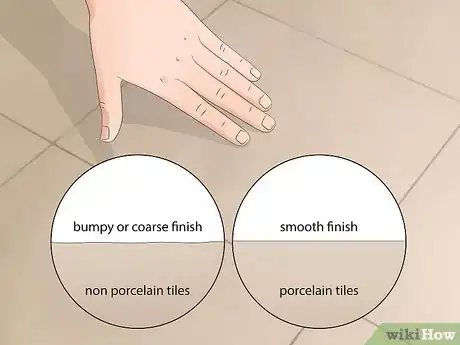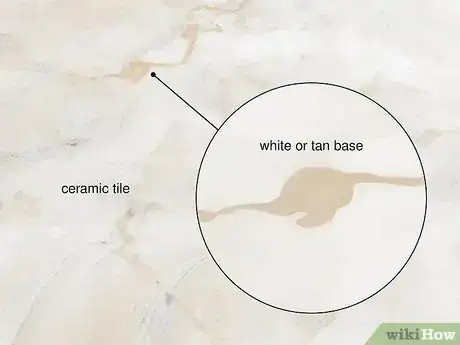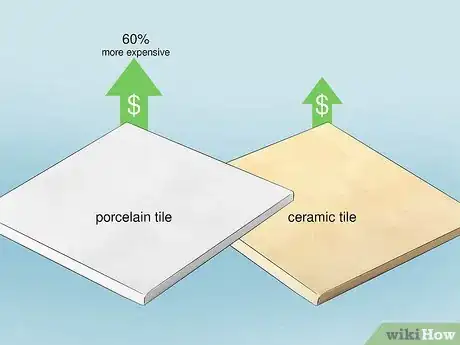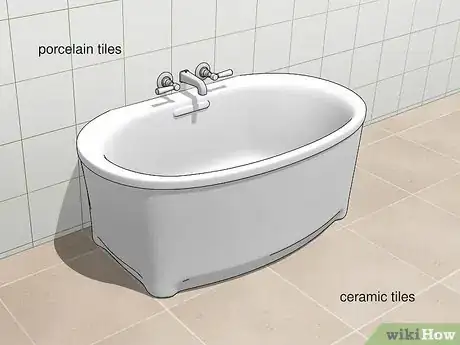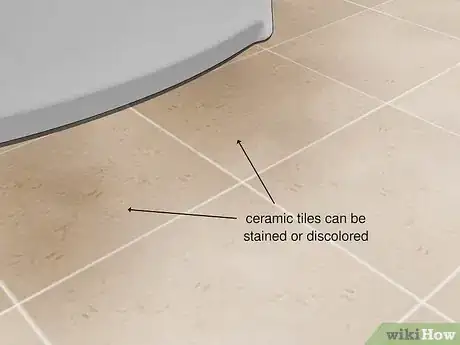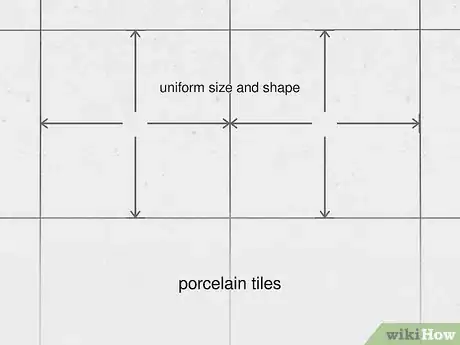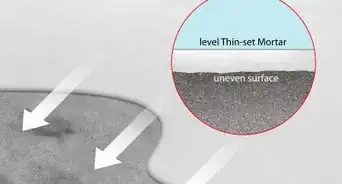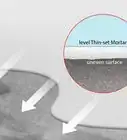This article was co-authored by Mitchell Newman. Mitchell Newman is the Principal at Habitar Design and its sister company Stratagem Construction in Chicago, Illinois. He has 20 years of experience in construction, interior design and real estate development.
This article has been viewed 488,233 times.
Before you buy tile for a tiling project, you should be able to identify porcelain and ceramic tiles. Both are made from a mixture of clays and other materials, then kiln-fired. Both porcelain and ceramic tile are in the category of “ceramic tile.” Ceramic tiles are divided into two groups: non-porcelain tiles (or ceramic) and porcelain tiles. In general terms, porcelain tiles are a higher quality and more resistant to damage, since they’re fired in a kiln at higher temperatures and made of less porous materials.[1]
Steps
Identifying Loose Tiles
-
1Inspect the tiles’ finish to see how smooth it is. You can do this either by visually inspecting the tiles’ top surfaces or by running your fingers over the top of the tiles. Porcelain tiles have a fine-grained finish that is smoother than the finish on ceramic tiles. So, if the finish is slightly bumpy or coarse when you touch it, you’re dealing with non-porcelain (ceramic) tile.[2]
- If the tiles are already glazed, flip them over and look at the unglazed underside.
-
2Look for chips in the glaze to identify ceramic tile. Look closely at the glaze: if it’s chipped, you will be able to see the tile’s white or tan base. This is a sure sign that the tile is ceramic.[3] Porcelain tiles are sometimes, but not always, glazed. Most high-quality porcelain tiles will have a consistent color that goes through the top, body, and bottom of the tile. Ceramic tiles, on the other hand, are nearly always glazed.
- Glazed porcelain tiles are much harder and are more resistant to wear and damage than non-porcelain ceramic tiles.
Advertisement -
3Examine the sides of the tile for a white, tan, or red color. While porcelain tiles can be colored, ceramic tiles will always have a white, tan, or red color, with a colored glaze on top. So, if you see that the sides (and base) of the tile are any other color other than white, tan, or red, you can be sure that you’re dealing with a porcelain tile.[4]
- Some cheap, low-quality porcelain tiles may not have the color mixed through the body of the tile. Avoid purchasing these tiles.
-
4Compare the costs of the two tile types. In nearly every scenario, porcelain tiles are more expensive than ceramic tiles: they take more time to produce, are more versatile, and tend to last longer. If you’re looking at two types of tiles in a hardware or home-supply store, non-porcelain (ceramic) tiles will be a little cheaper.[5]
- As a broad rule of thumb, porcelain tile usually costs approximately 60% more than ceramic tile.
Identifying Already-Installed Tiles
-
1Note the location in which the tiles have been installed. Ceramic and porcelain tiles are each better suited to distinct locations in a home. Porcelain is often installed in laundry rooms, bathroom floors, bathroom walls, shower stalls, and around bathtubs. Porcelain tile is more durable than ceramic because of its hardness, and porcelain is also more resistant to moisture.[6]
- Ceramic tile, on the other hand, is most often installed as flooring in high-traffic areas such as an entry way or a heavily-used hallway.
-
2See if the tiles are stained or discolored. If so, they’re almost certainly ceramic. Porcelain tiles are very dense and have been designed to be impervious to stains. So, most staining substances (e.g., red wine) can be wiped off of them easily. Ceramic, on the other hand, is light, porous, and can absorb staining materials relatively easily.[7]
- Stains on ceramic tiles could also come from foot traffic (dirt, mud, snow, etc.) if the tiles are located in an entryway.
-
3Inspect the faces of the tiles for uniform size and shape. The “face” of the tile is the top portion which faces upward or outward on installed tiles. Porcelain tiles have sharply-formed faces which are all exactly uniform in size. Due to their durability, porcelain tiles can be “rectified,” or cut to highly specific dimensions for complete uniformity. This also allows the porcelain tiles to be grouted together with only small gaps between tiles.[8]
- If there is any discrepancy between the size of the tiles, you’re dealing with ceramic tile.
Expert Q&A
-
QuestionHow can you tell if tile is porcelain?
 Mitchell NewmanMitchell Newman is the Principal at Habitar Design and its sister company Stratagem Construction in Chicago, Illinois. He has 20 years of experience in construction, interior design and real estate development.
Mitchell NewmanMitchell Newman is the Principal at Habitar Design and its sister company Stratagem Construction in Chicago, Illinois. He has 20 years of experience in construction, interior design and real estate development.
Interior Design Manager Porcelain tends to be flatter for the most part, and it just has a different look. Porcelain tiles have colored finish all the way through and they are much harder to cut than ceramic that is typically just colored on the surface and is usually relatively soft.
Porcelain tends to be flatter for the most part, and it just has a different look. Porcelain tiles have colored finish all the way through and they are much harder to cut than ceramic that is typically just colored on the surface and is usually relatively soft. -
QuestionDoes porcelain chip easily?
 wikiHow Staff EditorThis answer was written by one of our trained team of researchers who validated it for accuracy and comprehensiveness.
wikiHow Staff EditorThis answer was written by one of our trained team of researchers who validated it for accuracy and comprehensiveness.
Staff Answer wikiHow Staff EditorStaff AnswerThere are different grades of porcelain, and some chip more easily than others. In general, porcelain doesn’t chip as easily as ceramic, since it is denser. Chips tend to be more obvious on glazed porcelain than on unglazed porcelain.
wikiHow Staff EditorStaff AnswerThere are different grades of porcelain, and some chip more easily than others. In general, porcelain doesn’t chip as easily as ceramic, since it is denser. Chips tend to be more obvious on glazed porcelain than on unglazed porcelain. -
QuestionHow can you tell if a porcelain or ceramic tile is glazed?
 wikiHow Staff EditorThis answer was written by one of our trained team of researchers who validated it for accuracy and comprehensiveness.
wikiHow Staff EditorThis answer was written by one of our trained team of researchers who validated it for accuracy and comprehensiveness.
Staff Answer wikiHow Staff EditorStaff AnswerGlazed tiles have a smooth, glassy surface, while unglazed tiles are rougher and more porous.
wikiHow Staff EditorStaff AnswerGlazed tiles have a smooth, glassy surface, while unglazed tiles are rougher and more porous.
References
- ↑ https://theflooringgirl.com/blog/ceramic-tile-vs-porcelain-tile-whats-the-difference/
- ↑ https://www.bhg.com/home-improvement/tile/installation-how-to/ceramic-tile-porcelain-tile-flooring/
- ↑ https://www.bobvila.com/articles/porcelain-vs-ceramic-tile/
- ↑ https://www.bhg.com/home-improvement/tile/installation-how-to/ceramic-tile-porcelain-tile-flooring/
- ↑ https://www.bobvila.com/articles/porcelain-vs-ceramic-tile/
- ↑ https://www.bhg.com/home-improvement/tile/installation-how-to/ceramic-tile-porcelain-tile-flooring/
- ↑ https://www.bobvila.com/articles/porcelain-vs-ceramic-tile/
- ↑ https://www.bhg.com/home-improvement/tile/installation-how-to/ceramic-tile-porcelain-tile-flooring/
- ↑ https://theflooringgirl.com/blog/ceramic-tile-vs-porcelain-tile-whats-the-difference/
About This Article
To tell the difference between porcelain and ceramic tiles, inspect the tile’s finish, which will be smooth and even if the tile is porcelain. Then, examine the sides for a white, tan, or red color, which is a common sign of ceramic tiles. If the tiles are already installed, see if the they’re stained or damaged, which could be a sign that they’re ceramic, since porcelain tiles don’t usually crack or stain. You can also tell porcelain tiles by their uniform size and shape, and how they fit together with only small gaps in between. To learn more, like how to check the glaze to tell the difference between porcelain and ceramic tiles, read on!
